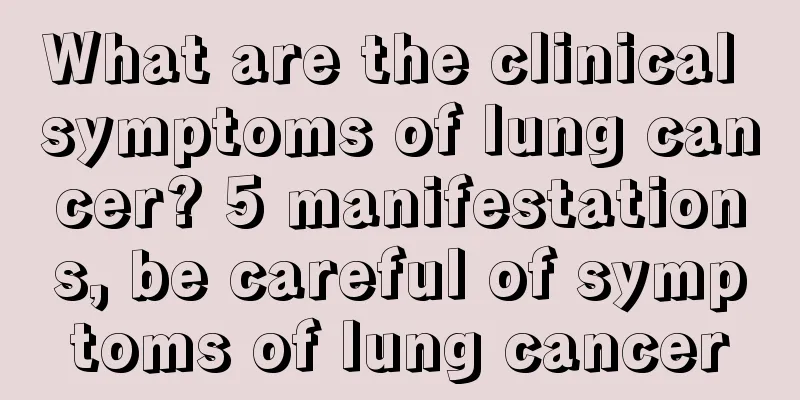What are the clinical symptoms of lung cancer? 5 manifestations, be careful of symptoms of lung cancer

|
Lung cancer is a disease with a particularly high morbidity and mortality rate. It is a major killer of people's health. Therefore, early detection and early treatment of lung cancer are very important. So, what are the symptoms of lung cancer? Let's take a look at the main symptoms of lung cancer. 1. Cough Cough is the most common symptom, with 35% to 75% of patients having cough as the first symptom. Cough caused by lung cancer may be related to changes in bronchial mucus secretion, obstructive pneumonia, pleural invasion, atelectasis and other intrathoracic complications. When the tumor grows in the bronchial mucosa above the segment with a larger diameter and sensitive to external stimuli, it can cause a cough similar to that caused by foreign body stimulation, typically manifested as paroxysmal irritating dry cough, which is often difficult to control with general cough suppressants. When the tumor grows in the smaller bronchial mucosa below the segment, the cough is often not obvious or even absent. For patients who smoke or suffer from chronic bronchitis, if the cough becomes more severe, the frequency changes, and the nature of the cough changes, such as a high-pitched metallic sound, especially in the elderly, be highly alert to the possibility of lung cancer. 2. Blood in sputum or hemoptysis Blood in sputum or hemoptysis is also a common symptom of lung cancer, accounting for about 30% of the first symptoms. Because tumor tissue is rich in blood supply and brittle in texture, blood vessels rupture and cause bleeding during severe coughing. Hemoptysis may also be caused by local tumor necrosis or vasculitis. The characteristics of lung cancer hemoptysis are intermittent or continuous, repeated small amounts of blood in sputum, or small amounts of hemoptysis, occasionally due to large blood vessel rupture, large cavity formation or tumor rupture into the bronchial and pulmonary blood vessels, leading to uncontrollable large hemoptysis. 3. Chest pain About 25% of patients have chest pain as the first symptom. It often manifests as irregular dull pain or pain in the chest. In most cases, peripheral lung cancer invades the parietal pleura or chest wall, which can cause sharp and intermittent pleural pain. If it continues to develop, it will evolve into constant drilling pain. Mild chest discomfort that is difficult to locate is sometimes related to central lung cancer invading the mediastinum or involving blood vessels and peripheral bronchial nerves, and 25% of patients with malignant pleural effusion complain of dull chest pain. Continuous, sharp and severe chest pain that is not easily controlled by drugs often indicates that there has been extensive pleural or chest wall invasion. Persistent pain in the shoulder or chest and back indicates that there may be tumor invasion near the mediastinum on the inner side of the lung lobe. 4. Chest tightness and shortness of breath About 10% of patients have this as the first symptom, which is more common in central lung cancer, especially patients with poor lung function. The main causes of dyspnea include: ① In the late stage of lung cancer, when the mediastinal lymph nodes are widely metastatic and compress the trachea, carina or main bronchi, shortness of breath or even suffocation may occur. ② When a large amount of pleural effusion compresses the lung tissue and causes severe displacement of the mediastinum, or when there is pericardial effusion, chest tightness, shortness of breath and dyspnea may also occur, but the symptoms can be relieved after fluid extraction. ③ Diffuse bronchioloalveolar carcinoma and bronchial disseminated adenocarcinoma reduce the respiratory area and gas diffusion dysfunction, leading to severe ventilation/perfusion ratio imbalance, causing dyspnea to gradually worsen, often accompanied by cyanosis. ④ Others: including obstructive pneumonia. Atelectasis, lymphangitic lung cancer, tumor microembolism, upper airway obstruction, spontaneous pneumothorax and combined chronic lung diseases such as COPD. 5. Hoarseness 5% to 18% of lung cancer patients present hoarseness as the first complaint, usually accompanied by cough. Hoarseness generally indicates direct mediastinal invasion or lymph node enlargement involving the ipsilateral recurrent laryngeal nerve, resulting in left vocal cord paralysis. Vocal cord paralysis can also cause varying degrees of upper airway obstruction. Through the above article, everyone should have understood the symptoms of lung cancer. In fact, the early symptoms of lung cancer are not particularly obvious to everyone. Therefore, physical examination is particularly important for everyone, and physical examination can detect the symptoms of lung cancer as early as possible. |
<<: What foods can prevent liver cancer? Eating more of these 4 foods can prevent liver cancer
>>: How to prevent liver cancer? Share several methods to prevent liver cancer
Recommend
Can I eat abalone after surgery
As we all know, abalone has a relatively high nut...
At what age do children abroad start watching pornography?
At what age do children abroad start watching por...
Will isolation cream clog pores
Many female friends are not unfamiliar with isola...
The cost of gastric cancer surgery in a cancer hospital
How much does it cost to perform gastric cancer s...
What are the methods for wearing masks
We always have to wear masks in our daily lives, ...
How can I enlarge my breasts after giving birth?
Every woman wants to have firm breasts, but some ...
What are the classifications of hypertension?
Hypertension is a chronic disease of the human bo...
How to prevent the occurrence of osteosarcoma
Nowadays, various diseases are everywhere. If we ...
Is it a big deal if rat blood touches the skin?
There are many microorganisms on animals' bod...
What is the cause of back pain? Be alert to disease factors
Sometimes back pain will get better by resting, w...
Congenital heart disease
The symptom of congenital heart disease is relati...
Six signs to remind you to protect your liver immediately
my country is a high-incidence area of liver di...
Life expectancy after uterine cancer surgery is related to the patient's physical function
After uterine cancer surgery, many people want to...
What are the differences between Chinese and Western medicine in treating liver cancer? How to manage the diet of liver cancer patients?
Liver cancer is the second most common cancer in ...
What to eat if you have uterine cancer
Oncologists point out that uterine cancer is very...









